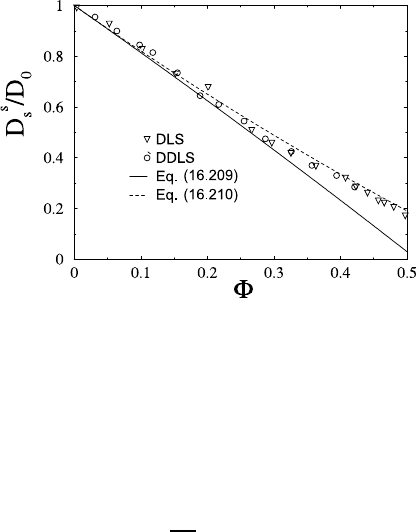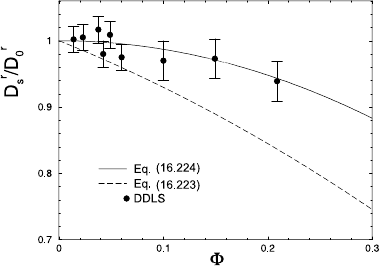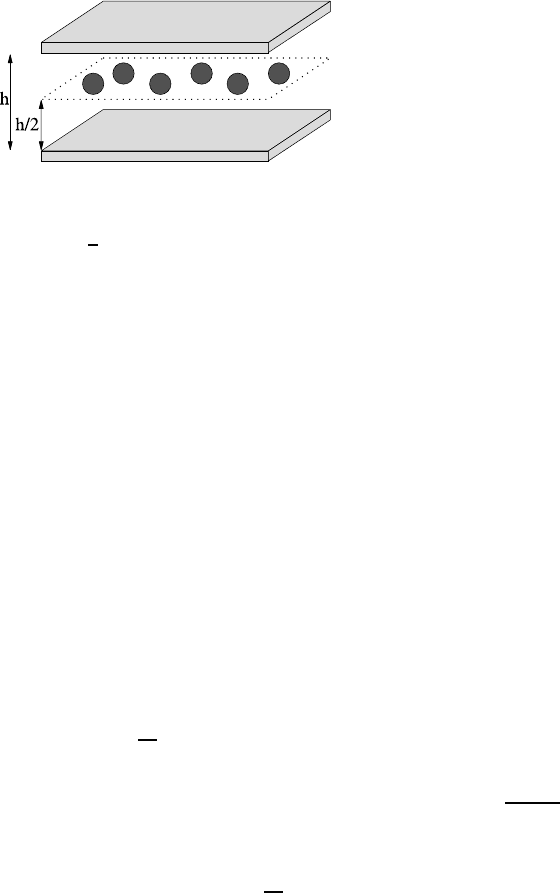Heitjans P., Karger J. (Eds.). Diffusion in Condensed Matter: Methods, Materials, Models
Подождите немного. Документ загружается.


680 Gerhard N¨agele, Jan K. G. Dhont, and Gerhard Meier
static distribution functions. Thus moment expansions are not very helpful
in gaining information on S
A
(q, t) for intermediate and long times. In the
following section, we will describe a projection operator method which is far
better suited for analyzing the dynamics at long times.
Incidentally, the second moment of S
A
(q, t) does not exist for systems
with singular pair potentials like suspensions of colloidal hard spheres. For
the latter case, the non-analytical short-time expansion of S
A
(q, t)isgiven
by
S
A
(q, τ)=S
A
(q) − τ +
4
√
π
3
C
A
(q; Φ)τ
3/2
+ ··· (16.202)
with τ = q
2
D
0
t. Explicit expressions for the expansion coefficients C
s
(q; Φ)
and C
c
(q; Φ) can be found in [24,48].
In order to obtain explicit results for the short-time translational property
H(q) and its limiting values U
s
and D
s
s
, it is necessary to specify the trans-
lational diffusivity tensors D
ij
(r
N
). For this purpose, it is useful to expand
D
ij
(r
N
), according to
D
ij
(r
N
)=D
0
1δ
ij
+ D
(2)
ij
(r
N
)+D
(3)
ij
(r
N
)+··· , (16.203)
into contributions, D
(n)
ij
(r
N
), originating from increasingly large clusters of
n hydrodynamically interacting spheres.
For (very) small volume fractions, it is justified to assume pairwise addi-
tivity of the HI. In this case
D
ij
(r
N
) ≈ D
0
1δ
ij
+ D
(2)
ij
(r
N
) , (16.204)
with
D
(2)
ij
(r
N
)=D
0
⎡
⎣
δ
ij
N
l=i
ω
11
(r
i
− r
l
)+(1− δ
ij
) ω
12
(r
i
− r
j
)
⎤
⎦
. (16.205)
The first term of (16.205) determines D
11
in (16.198) so that the tensor ω
11
modifies the short-time self-diffusion coefficient as compared to its value, D
0
,
at infinite dilution. The tensor ω
12
determines the distinct part, i = j,of
H(q). For one-component suspensions of spheres, series expansions of ω
11
(r)
and ω
12
(r) are known, in principle, to arbitrary order. The leading terms in
this long-distance expansions are
ω
11
(r)=−
15
4
a
r
4
ˆ
r
ˆ
r + O
a
r
6
(16.206)
ω
12
(r)=
3
4
a
r
[1 +
ˆ
r
ˆ
r]+
1
2
a
r
3
[1 − 3
ˆ
r
ˆ
r]+O
a
r
7
,
where
ˆ
r = r/r. The long-distance (i.e. far-field) expression for ω
12
(r)upto
O(r
−3
) is the well-known Rotne-Prager (RP) tensor [49].

16 Diffusion in Colloidal and Polymeric Systems 681
Substitution of (16.205) into (16.195) and (16.198) leads to the expressions
D
s
s
= D
0
1+ρ
0
dr g(r)
ˆ
q · ω
11
(r) ·
ˆ
q
(16.207)
H(q)=
D
s
s
D
0
+ ρ
0
dr g(r)
ˆ
q · ω
12
(r) ·
ˆ
q cos(q · r) , (16.208)
valid for pairwise additive HI. The only input needed to calculate D
s
s
and
H(q) from these expressions is the pair distribution function g(r). The latter
gives the conditional probability of finding a second sphere a distance r apart
from a given one. For given pair potential u(r), g(r) can be determined using
standard integral equation methods or computer simulations [18, 50]. For
neutral hard spheres, g(r) has its maximum at contact distance, r =2a
+
,
whereas it is practically equal to zero for charged spheres up to the nearest-
neighbor distance, where it attains a rather pronounced peak. This implies
that, contrary to dilute suspensions of charge-stabilized spheres, where only
the leading far-field terms in ω
ij
are of importance, many more terms need
to be summed up for neutral hard spheres.
The most accurate virial expansion result for the D
s
s
of monodisperse hard
spheres valid to second order in Φ reads [51]
D
s
s
D
0
=1− 1.832 Φ − 0.219 Φ
2
+ O(Φ
3
) . (16.209)
This result has been obtained from summing up a large number of terms in the
inverse-distance expansions of D
(2)
11
and D
(3)
11
, and by further accounting for
short-range lubrication interactions between nearly touching pairs or triplets
of spheres. Three-body terms in D
11
, which contribute to D
s
s
to order Φ
2
,
appear first in order r
−7
.
Fig. 16.21 depicts D
s
s
, determined according to (16.209), in comparison
with DLS and depolarized DLS data on hard spheres, and with the semi-
empirical formula,
D
s
s
D
0
=(1− 1.56Φ)(1− 0.27Φ) , (16.210)
proposed by Lionberger and Russel [53]. The latter formula conforms to the
(numerically) exact O(Φ) limit in (16.209), and it predicts D
s
s
to vanish at
the volume fraction Φ
rcp
≈ 0.64 where random close packing occurs. As
seen in Fig. 16.21, the second-order virial form is applicable for Φ<0.3. The
experimental data are overall well described by (16.210) up to Φ ≈ 0.5, where
the systems begins to freeze into an ordered solid state.
For small Φ, the sedimentation velocity of hard spheres has been deter-
mined to linear order by Batchelor [54], and to quadratic order by Cichocki
et. al. [55], as
U
s
U
0
=1− 6.546 Φ +21.918Φ
2
+ O(Φ
3
) . (16.211)

682 Gerhard N¨agele, Jan K. G. Dhont, and Gerhard Meier
Fig. 16.21. Reduced short-time translational self-diffusion coefficient, D
s
s
/D
0
,of
monodisperse hard-sphere suspensions. We compare experimental DLS [26] and
DDLS [31] data with the O(Φ
2
) expression in (16.209), and the semi-empirical
expression in (16.210). After [32, 52].
Using that S
c
(q =0)=1− 8Φ +34Φ
2
+ O(Φ
3
), the short-time collective
diffusion coefficient of hard spheres at low concentrations is determined as [55]
D
s
c
D
0
=1+1.454Φ − 0.45Φ
2
+ O(Φ
3
) , (16.212)
which shows that D
s
c
>D
0
. The modest initial increase in D
s
c
with Φ de-
scribed by (16.212) is counter-operated by HI through the factor H(0), which
causes D
s
c
to decay towards zero for larger Φ.
For hard spheres up to Φ =0.5, it has been shown in comparison to exact
low-density calculations [56], experimental data [26] and so-called Lattice-
Boltzmann computer simulation results for H(q) [26], that [24, 56]
H(q
m
)=1− 1.35Φ. (16.213)
The Lattice-Boltzmann simulation method combines Newtonian dynamics of
the solid colloidal particles with a discretized Boltzmann-type equation for
the fluid phase (see, e.g., [57]). It is particularly suited to analyze the effect
of many-body HI on the colloidal short-time dynamics.
The principal peak height, S
c
(q
m
), of the hard-sphere static structure
factor is well described, within 0 <Φ<0.5, by [24,58]
S
c
(q
m
)=1+0.644Φg(r =2a
+
) , (16.214)
where g(r =2a
+
)=(1− 0.5Φ)/(1 − Φ)
3
is the Carnahan-Starling contact
value of g(r). Note that S
c
(q
m
) ≈ 2.85 at Φ =0.494, in accord with the
empirical Hansen-Verlet freezing criterion [59]. This criterion states for one-
component atomic and colloidal liquids that freezing into an ordered state

16 Diffusion in Colloidal and Polymeric Systems 683
sets in when S
c
(q
m
) exceeds 2.8 − 3.0. Substitution of (16.213) and (16.214)
into D
s
c
(q
m
)=D
0
H(q
m
)/S
c
(q
m
) gives an analytic expression for the short-
time apparent collective diffusion coefficient, D
s
c
(q
m
), which, according to Fig.
16.11, is in perfect agreement with experimental data.
Calculations of the hard-sphere H(q) in dependence on q have been per-
formed by Beenakker and Mazur [60]. These involved calculations account in
an approximate way for many-body HI contributions (through so-called ring
diagrams), with results for H(q) which agree, up to Φ ≈ 0.3, quite well with
experimental data and Lattice-Boltzmann computer simulations [26].
The shape of H(q) is rather similar to that of S
c
(q) for the same Φ.The
maximim of H(q) is located close to q
m
. However, according to (16.213),
H(q
m
) decreases linearly in Φ, while S
c
(q
m
) is instead a monotonically in-
creasing function in φ (see (16.214)).
Having discussed the short-time properties of colloidal suspensions with
short-range, i.e. hard-sphere-like, pair interactions, we proceed to discuss the
opposite case of charge-stabilized suspensions with long-range electrostatic
repulsions among the particles. We examine in particular systems with small
amounts of excess electrolyte (in addition to the neutralizing counterions).
The highly charged colloidal particles in these systems are already strongly
correlated at volume fractions as low as Φ ≈ 10
−4
. The strong electrosta-
tic repulsion keeps the particles apart from each other such that contact
configurations are extremely unlikely. Contrary to hard-sphere dispersions in
which near-field hydrodynamic lubrication forces are important, the diffusion
of charged colloidal spheres is thus influenced only by the far-field part of the
HI. This salient difference in the effect of the HI leads to remarkable qualita-
tive differences in the dynamic behavior of charge-stabilized dispersions and
suspensions of hard spheres.
The usual virial expansion in Φ, which is so successful for semi-dilute
hard-sphere suspensions, does not apply to charge-stabilized suspensions.
Non-linear volume fraction dependencies have been predicted instead by
N¨agele and co-workers for the short-time transport properties of monodis-
perse charge-stabilized dispersions [18,61–66]. In particular, D
s
s
obeys a frac-
tional Φ-dependence of the form [18]
D
s
s
D
0
=1− a
t
Φ
4/3
, (16.215)
with a parameter a
t
≈ 2.5 which depends only weakly on the charge of the
colloidal particle, provided that the charge remains large enough to mask
the physical hard core of the particle. Equation (16.215) is valid typically for
Φ ≤ 0.05. At larger volume fractions, three- and more-body HI come into play,
and (16.215) becomes invalid. The Φ
3/4
-dependence of D
s
s
has been verified
in recent DLS measurements on charge-stabilized suspensions with the excess
electrolyte (i.e. excess salt ions) removed form the suspension using an ion
exchange resin [67]. According to (16.215), the D
s
s
of charged spheres is less
strongly reduced by HI than for hard spheres at the same volume fraction. In

684 Gerhard N¨agele, Jan K. G. Dhont, and Gerhard Meier
case of hard spheres, lubrication forces between nearby spheres are operating
whereas the dynamics of charged spheres is dominated by far-field HI.
HI have a stronger effect on charged spheres than on neutral ones, when
instead of D
s
s
the sedimentation velocity in a homogeneous system is con-
sidered. In this case, theory predicts for charge-stabilized suspensions with
Φ<0.1that
U
s
U
0
=1− a
s
Φ
1/3
, (16.216)
with a nearly charge- and particle size-independent coefficient a
s
≈ 1.8 [18,
62, 63]. The fractional exponent 1/3 has been subsequently confirmed by
measurements of the sedimentation velocity in deionized charge-stabilized
suspensions [66]. Equation (16.216) predicts, for Φ =10
−3
, a reduction in U
s
from the zero-density limit U
0
by as much as 15%, whereas the reduction for
hard spheres at the same Φ is as small as 0.4% (cf. (16.211)). This is quite
remarkable, for in the past the influence of HI on dilute charge-stabilized
dispersions had been frequently considered to be negligibly small. The origin
for the smaller sedimentation velocity of charged spheres as compared to
uncharged ones at the same Φ is that charged particles are more strongly
exposed to laminar solvent friction arising from the cumulative backflow of
displaced fluid. This backflow friction is more effective for charged particles
since, contrary to neutral spheres, nearby particle pairs are very unlikely.
The strong influence of (far-field) HI on charged particles can be ob-
served further in the significant wavenumber dependence of H(q). For charged
spheres at Φ ≤ 10
−2
, it is sufficient to substitute in (16.195) the Rotne-Prager
limiting form of D
ij
given in (16.207). This leads to [68]
H(y)=1− 15Φ
j
1
(y)
y
+18Φ
∞
1
dxx [g(x) − 1] {j
0
(xy) −
j
1
(xy)
xy
+
j
2
(xy)
6x
2
}, (16.217)
with y =2qa, x = r/(2a), and j
n
the spherical Bessel function of order
n.DLSdataofH¨artl and co-workers [69] for the hydrodynamic function
of dilute charge-stabilized suspensions are displayed in Fig. 16.22 for three
different concentrations. Notify the pronounced oscillations of H(q)evenfor
the smallest Φ ≈ 10
−4
considered. The experimental H(q) are overall in very
good agreement with the theoretical result in (16.217). The differences at
small q can be attributed to the scattering contribution of residual particle
aggregates in the experimental probes and to polydispersity effects, which are
most influential at small q. The radial distribution function in (16.217) was
determined from fitting the peak heights, S
c
(q
m
), of the experimental S(q)
in Fig. 16.22 by static structure factors calculated by means of the rescaled
mean spherical integral equation scheme (RMSA).
Contrary to hard spheres, the peak height, H(q
m
), of dilute and deionized
charged sphere suspensions is larger than one, and it grows with increasing

16 Diffusion in Colloidal and Polymeric Systems 685
Fig. 16.22. Static structure factor S
c
(q)(upper figure) and hydrodynamic function
H(q) (lower figure) versus qa for aqueous dispersions of strongly charged spheres
at Φ =7.63 × 10
−4
,2.29 × 10
−3
,and4.58 × 10
−3
(curves from left to right). Note
that without HI, H(q) ≡ 1. After [69].
Φ.ForΦ ≤ 10
−2
, this peak height is well described by [24,56]
H(q
m
)=1+pΦ
0.4
, (16.218)
with a coefficient p =1− 1.5 moderately dependent on particle size and
charge.
We have dealt so far with translational short-time properties. The rota-
tional short-time self-diffusion coefficient, D
r
s
, of interacting colloidal spheres
defined in (16.148) can be calculated in analogy with the translational case
by accounting also for the orientational degrees of freedom [1, 20, 31, 32, 64].
In this way, one obtains the microscopic expression
D
r
s
=
ˆ
q · D
rr
11
(r
N
) ·
ˆ
q (16.219)
for D
r
s
. The rotational diffusivity tensor, D
rr
11
, relates the hydrodynamic
torque, T
H
1
, acting on a representative sphere 1 to its angular velocity, ω
1
,
by

686 Gerhard N¨agele, Jan K. G. Dhont, and Gerhard Meier
ω
1
= −
1
k
B
T
D
rr
11
(r
N
) · T
H
1
, (16.220)
on assuming that no hydrodynamic torques and forces are exerted on the
remaining (N − 1) spheres. To leading order in the a/r expansion, D
rr
11
(r
N
)
is given by [70]
D
rr
11
(r
N
)=D
r
0
⎡
⎣
1 +
N
l=i
ω
rr
11
(r
i
− r
l
)
⎤
⎦
, (16.221)
with
ω
rr
11
(r)=−
15
4
a
r
6
[1 −
ˆ
r
ˆ
r]+O
a
r
8
. (16.222)
The leading-order three-body contribution to D
rr
11
(r
N
)isoforderr
−9
[32,51].
On the basis of (16.219), Cichocki et al. [51] have derived for hard spheres
the second-order virial expansion result
D
r
s
D
r
0
=1− 0.631Φ − 0.726Φ
2
. (16.223)
This expression describes experimental data and Lattice-Boltzmann com-
puter simulation results for D
r
s
quite well up to surprisingly large volume
fractions Φ =0.4 [31,52, 72].
Calculations of D
r
s
for charge-stabilized suspensions with leading-order
three-body HI included, reveal for small excess electrolyte concentration a
purely quadratic Φ-dependence, viz.
D
r
s
D
r
0
=1− a
r
Φ
2
, (16.224)
with a parameter a
r
≈ 1.3 rather insensitive to particle size and charge.
Equation (16.224) has been confirmed by Lattice-Boltzmann computer sim-
ulations, which show that it applies quite accurately even up to Φ ≈ 0.3 [72].
Figure 16.23 includes the comparison between the theoretical prediction
for D
r
s
in (16.224), and depolarized DLS measurements of Bitzer et al. [71] on
deionized suspensions of highly charged and optically anisotropic fluorinated
teflon spheres. For comparison, Fig. 16.23 contains further the hard-sphere
D
r
s
according to (16.223). The experimental data for D
r
s
are seen to be in
qualitative accord with the predicted φ
2
dependence.
The non-linear volume fraction dependence of the short-time properties
of charged spheres arises from the peculiar concentration dependence of the
mean diameter, r
m
, of the average next-neighbor cage around a charged
sphere. The length r
m
coincides with the location of the first maximum,
g(r
m
), of the radial distribution function and is very nearly equal to the
mean interparticle distance, ρ
−1/3
0
,whichscalesinΦ as Φ
−1/3
.Usingthis

16 Diffusion in Colloidal and Polymeric Systems 687
Fig. 16.23. DDLS data (from [71]) and (16.224) for the reduced short-time ro-
tational self-diffusion coefficient, D
r
s
/D
r
0
,versusΦ of charge-stabilized colloidal
spheres. The second-order virial expansion result in (16.223) for monodisperse hard
spheres is included for comparison.
characteristic property of deionized charge-stabilized suspensions, the expo-
nents in (16.215), (16.216), (16.218) and (16.224) can be derived quite easily
on the basis of a simplified model of effective hard spheres of diameter 2r
m
.
We refer to [18,63, 65] for more details on the effective hard-sphere model.
Long-Time Diffusion
Theoretical calculations of the intermediate time and long-time behavior of
S
c
(q, t)andS
s
(q, t), the MSD and the associated translational long-time self-
diffusion coefficient are very demanding, since these quantities are affected
simultaneously by direct and hydrodynamic interactions. These interactions
give rise to time-retarded caging effects. At long times t τ
I
, the dynamic
cage around a sphere is distorted away from its, on the average, spherical
symmetry. This implies that, contrary to D
s
s
, D
l
s
cannot be expressed in
terms of a genuine equilibrium average as the one in (16.198).
A frequently used route to a direct calculation of time dynamic properties
at intermediate to long times invokes Brownian dynamics (BD) computer sim-
ulations without and, to a certain degree of approximation, with HI included.
The BD method allows to generate numerically the trajectories {r
i
(t)} of col-
loidal spheres, and it is statistically equivalent to solving the GSE (16.183) for
the many-sphere pdf. The (translational) displacements of N identical col-
loidal spheres during a time step ∆t,withτ
B
t τ
I
, are generated in this
scheme through solving the coupled stochastic finite difference equations [73]
r
i
(t + ∆t) − r
i
(t)=
N
j=1
[−βD
ij
(r
N
) ·∇
j
U(r
N
)+∇
j
· D
ij
(r
N
)]∆t + ∆x
i
+ O(∆t
2
) . (16.225)

688 Gerhard N¨agele, Jan K. G. Dhont, and Gerhard Meier
Here, ∆x
i
is a Gaussian-distributed random displacement vector of zero mean
∆x
i
= 0 due to isotropy, and the covariance matrix
∆x
i
∆x
j
=2D
ij
(r
N
)∆t . (16.226)
For dilute suspensions with long-range repulsive interactions, we have argued
before that it is sufficient to account only for the leading asymptotic form
of D
ij
, given for an unbound three-dimensional suspension by the Rotne-
Prager form in (16.205). Equation (16.225) reduces then to a simpler form,
since ∇
j
· D
ij
= 0 within RP approximation. The RP approximation for
D
ij
amounts to neglecting reflections, through other (caging) spheres, of the
hydrodynamic flow field created by a moving sphere onto itself. Therefore,
D
s
s
= D
0
within RP approximation. For dilute charge-stabilized suspensions,
DLS experiments show indeed that D
s
s
≈ D
0
.
In a typical BD simulation, several hundred to several thousand particles
confined in a periodically repeated simulation box are equilibrated using,
e.g., a canonical ensemble Monte-Carlo method. After equilibration has been
reached, several ten thousand production time steps are generated by the
algorithm in (16.225) to obtain diffusional (and structural) properties like
the particle MSD through
W (t)=
1
2d
=
1
N
N
i=1
[r
i
(t) − r
i
(0)]
2
>
, (16.227)
with t some multiple of ∆t. The long-range nature of the HI requires to
include an Ewald-type summation technique on the RP level into the BD
algorithm, as developed by Beenakker [75]. The influence of HI on dynamic
properties can be analyzed through comparison with BD calculations where
HI are disregarded, by setting D
ij
= D
0
δ
ij
1. An example for a BD calculation
of S
c
(q, t) without HI has been discussed already in Fig. 16.8, in comparison
with a mode coupling theory scheme which will be explained further down.
BD simulations with far-field HI included have been performed, e.g., for the
in-plane diffusion of planar monolayers of charge-stabilized colloidal spheres
[74] and for one-component [58,76–78] and bidisperse [79] systems of super-
paramagnetic colloidal spheres confined to a liquid-gas interface, and exposed
to an external magnetic field perpendicular to the interface. The induced
magnetic moments in the particles lead to long-range dipolar repulsions. A
BD study of three-dimensional charge-stabilized suspensions with far-field HI
has been discussed in [80].
For an interesting example of a quasi-two-dimensional colloidal suspen-
sion, consider a monolayer of electrostatically repelling colloidal spheres dif-
fusing in the midplane between two narrow parallel (charged) walls of sepa-
ration h =2σ,withσ =2a (see Fig. 16.24).
Due to the stronger influence of HI in such confined systems, it is neces-
sary to account for many-body near-field HI (where ∇
j
· D
ij
= 0) between

16 Diffusion in Colloidal and Polymeric Systems 689
Fig. 16.24. Charged colloidal spheres diffusing in the midplane between two
charged plates. The spheres interact by the screened Coulomb potential u(r)=
Q
2
exp{−κr}/r for r>2a,withparticlechargeQ and screening parameter
κ = π/(h
√
2) (see [74] for details).
particles and walls (p-w HI), and among the particles themselves (p-p HI),
including also lubrication corrections. Lubrication effects arise when two or
more spheres or a sphere and a wall are close to contact: for stick boundary
conditions, which we assume here to apply, the mobility for relative motion
goes to zero at contact, due to strong lubrication stresses required to expel
the solvent from the thin gap between the surface points of closest approach.
Moreover, in the present system there is a non-negligible hydrodynamic cou-
pling between the translational and rotational motion of the spheres. To
include all these hydrodynamic features of the system one can use the so-
called Stokesian dynamics (SD) simulation method. This method is a more
sophisticated extension of the BD scheme, pioneered and advanced by Brady
and Bossis [81], which accounts to a good approximation for many-body HI
contributions and lubrication effects.
Figure 16.25 includes SD simulation results [74] for the self-dynamic and
distinct space-time Van Hove functions G
s
(r, t)andG
d
(r, t), respectively,
defined as [18]
G
s
(r, t)=
=
1
N
N
i=1
δ(r − r
i
(t)+r
i
(0))
>
≈ [4πW(t)]
−d/2
exp{−
r
2
4W (t)
} (16.228)
and
G
d
(r, t)=
=
1
N
N
i=j
δ(r − r
i
(t)+r
j
(0))
>
. (16.229)
The second approximate equality in (16.228) applies only when non-Gaussian
contributions to G
s
(r, t) are very small. The function G
s
(r, t) gives the condi-
tional probability density that a particle undergoes a displacement r during
the time interval t. The distinct Van Hove function, with G
d
(r, 0) = ρ
0
g(r),
gives the conditional probability density of finding, at time t, a particle a dis-
tance r apart from another one at earlier time t = 0. Up to the density factor
